FREE Standard Shipping On All Orders $100 or More!*
How to Use a Swimming Pool Filter Cleaner
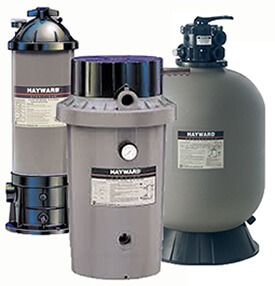
Swimming pool filters trap dirt and oils which coalesce into a gummy, goopy substance that goes by the industry technical term "gunk" or in a sand filter, "mud-balls".
Minerals and metals are also trapped inside the filter media, buried deep in the fibers of DE grids or filter cartridges, and in sand filters, turning the sand into something resembling sand stone.
When trapped oils and scale build up in your filter, it reduces water flow rates in the these areas of the filter media, and transfers higher flow rates in other areas. This results in ineffective filtration, and reduces the lifespan of the filter media - your sand, grids or cartridges.
Today, we discuss how to use pool filter cleaners, to remove filter-clogging oils and scale. Use after spring start-up to rejuvenate your pool filter media, and restore full filtration.
CARTRIDGE POOL FILTER CLEANERS
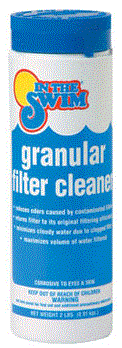
Cartridge filters use a pleated fabric of woven polyester. Thousands of fibers trap dirt and oils, minerals and metals deep within the cartridge. Hosing the cartridge with high pressure water is fairly effective at removing debris, but not so good at removing oil and mineral scale or metal stains. And, high pressure water damages a filter cartridge, by forcing apart the fibers of the fabric, which reduces a cartridges dirt holding capacity.
To clean a cartridge pool filter, remove the cartridges from the tank and give it a good hosing first, to remove visible debris. Now fill a small trash can or large bucket with water and pour in the granular filter cleaner. Stir to dissolve and then drop in your filter cartridges for an overnight soaking. If your bucket is short, flip the cartridge over halfway through, to clean the entire cartridge.
After cleaning, remove the cartridge from the solution and hose it clean thoroughly, until the suds stop forming. Now - the part that most people disregard, is to allow the cartridge to dry completely before replacing it in the tank, to kill any bacteria deep in the pleats. This is why having two sets of filter cartridges is recommended, so you can continue filtering while the 24 hour process of cleaning and drying takes place.
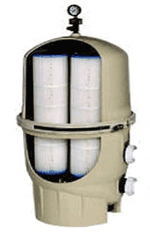
You can also use a small amount of DicaPool which does increase the efficiency of the cartridge by adding another filtration layer. You'll notice over time, that either the water doesn't look so good anymore, or that you have to clean the filter twice as often as when they were new. So, it is a good idea to replace cartridges every few years, or after about 12-15 cleanings.
D.E. POOL FILTER CLEANERS
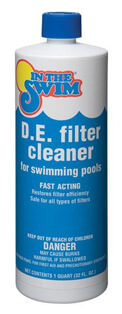
DE filter grids are made of a fine mesh that is smaller than a diatomaceous earth particle, to keep them from passing through to the pool. The woven fabric is such a tight weave, that it can clog up rather easily, which raises the filter pressure and reduces water flow.
Backwashing a DE filter only removes about 70% of the DE powder and dirt that is coating the grids, and large portions of the grids are not flushed at all during a backwashing. This is why it's important to remove the DE grid assembly once or twice per year to clean thoroughly with a garden hose.
But a garden hose won't remove minerals, metals or oils. Minerals such as calcium and metals such as iron can clog the tiny pores of DE grids and oils and polymer clarifiers present another problem. Minerals can be removed with a light acid bath and oils can be removed with a degreaser like TSP but if you do it wrong, or use acid first, it can set the oils making them impossible to remove. Better to just use our one step DE Filter Cleaner, to remove both at the same time.
To use DE filter cleaner, fill a small trash can half full of water and add the DE filter grid cleaner according to directions. Allow to soak overnight, or for several hours, flipping if necessary and then remove for a good cleaning with the garden hose, before replacing the grids back into the filter tank. Do this once per year, to keep oil and scale from affecting performance.
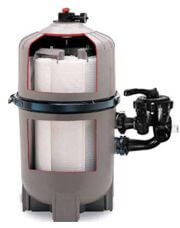
Using the correct amount of DE powder (at start up, and [less] after backwashing) will help to improve filtration and time between backwashing. Too little or too much DE powder can reduce your filter's effectiveness. Like filter sand, there is a DE substitute called DicaPool which uses half as much as regular DE. It's made of cellulose paper pulp, so it's environmentally friendly too!
SAND POOL FILTER CLEANERS

A sand pool filter uses specially graded sand that is about half a millimeter across, known as #20 silica sand. When matched with the right sized pump, sand filters are very effective in trapping dirt and oils.
Backwashing a sand filter is not as effective at releasing trapped dirt and oils however. Smaller, lighter debris and dirt is flushed out, but heavier minerals and oils coagulate together in clumps that fill the top few inches of filter sand.
You could replace the top few inches of sand every year, or use our Sand Filter Cleaner, to remove oils, minerals and metals that make your filter much less efficient. When mud-balls and calcification occurs, the water creates well-worn channels that funnel the pool water through the filter, without much filtration.
To use pool sand filter cleaner just add it through the skimmer, with the filter valve on the backwash position. After the cleaner is sucked into the filter, shut off the pump and allow the chemical to work overnight. Start it up again the next morning on rinse, to flush out dirt, oils and minerals. Use annually to rejuvenate your filter sand, and keep your filter operating at full effect!
There are sand substitutes available which offer better filtration and you use less of it than regular filter sand. ZeoSand is a sand alternative that filter much better than regular filter sand, and actually has some ability to trap heavy metals and ammonia. When using Zeosand, it also needs to be cleaned and refreshed (or re-ionized) every few seasons, with Bio-Dex Zeo Sand Cleaner.